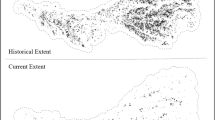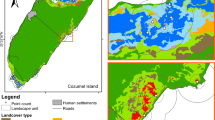Abstract
In Central Europe vast wetland areas have been converted into agricultural land over the past few centuries. Long-term spatially explicit reconstructions of wetland cover changes at regional scale are rare but such information is vital for setting appropriate wetland conservation and restoration goals. In this study wetland cover change over the past 150 years was analyzed for the Canton Zurich (Switzerland) using information from historical and current topographical maps. Mapping instructions changed significantly over time, i.e., wetlands were mapped more conservatively on older maps. Therefore a technique was developed to account for changes in mapping instructions and to reconstruct a series of comparable maps spanning 1850–2000. Wetland cover dramatically decreased from 13,759 ha in 1850 (more than 8% of the total study area) to 1,233 ha in 2000 (less than 1%). Largest loss is observed for the first half of the twentieth century when more than 50% of the total wetland loss occurred. In 1850, almost all wetland patches were connected in two large networks defined by a 500 m buffer around all wetland patches to account for typical dispersal distances of wetland animals. Despite extensive wetland loss, this networks remained largely intact until 1950, but then collapsed into many medium and small networks consisting of only few wetland patches. In addition to the direct loss of wetland habitats increased habitat fragmentation is limiting metapopulation dynamics and hindering genetic exchange between populations. Amphibians and other wetland animals are particularly prone to habitat fragmentation because of their limited migration abilities. This may lead to time-delayed extinction in the future because current species occurrence might rather reflect historical than current wetland cover and habitat configuration. Future restoration efforts should focus on reestablishing connectivity between remaining smaller wetland networks.







Similar content being viewed by others
References
Allouche O, Steinitz O, Rotem D, Rosenfeld A, Kadmon R (2008) Incorporating distance constraints into species distribution models. J Appl Ecol 45:599–609
Angelone S, Holderegger R (2009) Population genetics suggests effectiveness of habitat connectivity measures for the European tree frog in Switzerland. J Appl Ecol 46:879–887
Begert M, Schlegel T, Kirchhofer W (2005) Homogenous temperature and precipitation series of Switzerland from 1864 to 2000. Int J Climatol 25:65–80
Beilman DW, MacDonald GM, Smith LC, Reimer PJ (2009) Carbon accumulation in peatlands of Western Siberia over the last 2000 years. Glob Biogeochem Cycles 23:GB1012
Bender DJ, Contreras TA, Fahrig L (1998) Habitat loss and population decline: a meta-analysis of patch size effect. Ecology 79:517–533
Bertiller R, Schwick C, Jaeger J (2007) Landschaftszerschneidung in der Schweiz: Zerschneidungsanalyse 1885–2002 und Folgerungen für die Verkehrs- und Raumplanung. ASTRA Bericht Nr. 1175, Bundesamt für Strassen, Bern
BFS Bundesamt für Statistik (1992) Bodeneignungskarte der Schweiz. Neuchâtel
BFS Bundesamt für Statistik (2001) Arealstatistik der Schweiz 1992/1997. Neuchâtel
Bolliger J, Schulte LA, Burrows SN, Sickley TA, Mladenoff DJ (2004) Assessing ecological restoration potentials of Wisconsin (U.S.A.) using historical landscape reconstructions. Restor Ecol 12:124–142
Boughton EH, Quintana-Ascencio PF, Bohlen PJ, Jenkins DG, Pickert R (2010) Land-use and isolation interact to affect wetland plant assemblages. Ecography 33:461–470
Boyce MS, Vernier PR, Nielsen SE, Schmiegelow FKA (2002) Evaluating resource selection functions. Ecol Model 157:281–300
Bürgi M, Gimmi U (2007) Three objectives of historical ecology: the case of litter collecting in Central European forests. Landscape Ecol 22:77–87
Chefaoui RM, Hortal J, Lobo JM (2005) Potential distribution modeling, niche characterization and conservation status assessment using GIS tools: a case study of Iberian Copris species. Biol Conserv 122:327–338
Chin KS, Taylor PD (2009) Interactive effects of distance and matrix on the movements of a peatland dragonfly. Ecography 32:715–732
Clymo RS, Turunen J, Tolonen K (1998) Carbon accumulation in peatland. Oikos 81:368–388
DiGiulio M, Holderegger R, Tobias S (2009) Effects of habitat and landscape fragmentation on humans and biodiversity in densely populated landscapes. J Environ Manag 90:2959–2968
Egan D, Howell EA (2001) The historical ecology handbook. Island Press, Washington, DC
Ewald KC, Klaus G (2010) Die ausgewechselte Landschaft. Vom Umgang der Schweiz mit ihrer wichtigsten natürlichen Ressource. Verlag Haupt, Bern
Fahrig L (2003) Effects of habitat fragmentation on biodiversity. Annu Rev Ecol Evol Syst 34:487–515
Gagné SA, Fahrig L (2007) Effect of landscape context on anuran communities in breeding ponds in the National Capital region, Canada. Landscape Ecol 22:205–215
Gibbs JP (2000) Wetland loss and biodiversity conservation. Conserv Biol 14:314–317
Gibbs JP, Whiteleather KK, Schueler FW (2005) Changes in frog and toad populations over 30 years in New York State. Ecol Appl 15:1148–1157
Gimmi U, Stuber M, Bürgi M (2008) Reconstructing anthropogenic disturbance regimes in forest ecosystems: a case study from the Swiss Rhone valley. Ecosystems 11:113–124
Grosjean G (1996) Geschichte der Kartographie. Geographisches Institut der Universität Bern, Bern
Grossinger RM, Striplen CJ, Askevold RA, Brewster E, Beller EE (2007) Historical landscape ecology of an urbanized California valley: wetlands and woodlands in the Santa Clara valley. Landscape Ecol 22:103–120
Grünig A (ed) (1994) Mires and man: mire conservation in a densely populated country—the Swiss experience. Swiss Federal Institute for Forest, Snow and Landscape Research, Birmensdorf
Gugerli D, Speich D (2002) Topographien der Nation. Politik, kartographische Ordnung und Landschaft im 19. Jahrhundert. Chronos Verlag, Zürich
Gustafson EJ, Gardner RH (1996) The effect of landscape heterogeneity on the probability of patch colonization. Ecology 77:94–107
Hamer AJ, McDonnell MJ (2008) Amphibian ecology and conservation in the urbanizing world: a review. Biol Conserv 141:2432–2449
Hantke R (1980) Eiszeitalter: Die jüngste Erdgeschichte der Schweiz und ihrer Nachbargebiete. Ott, Thun
Hirzel AH, Hausser J, Chesse lD, Perrin N (2002) Ecological-niche factor analysis: how to compute habitat-suitability maps without absence data? Ecology 83:2027–2036
Hirzel AH, Le Lay G, Helfer V, Randin C, Guisan A (2006) Evaluating the ability of habitat suitability models to predict species presences. Ecol Model 199:142–152
Janssens IA, Freibauer A, Schlamadinger B, Ceuelmans R, Ciais P, Dolman AJ, Heiman M, Nabuurs GJ, Smith P, Valentini R, Schulze ED (2005) The carbon budget of terrestrial ecosystems at country-scale—a European case study. Biogeosciences 2:15–26
Kienast F (1993) Analysis of historic landscape patterns with a Geographical Information System—a methodological outline. Landscape Ecol 8:103–118
Kindlmann P, Burel F (2008) Connectivity measures: a review. Landscape Ecol 23:879–890
Klaus G (ed) (2007) Zustand und Entwicklung der Moore in der Schweiz. Ergebnisse der Erfolgskontrolle Moorschutz. Umweltzustand Nr. 0730. Bundesamt für Umwelt, Bern
Küster H (1999) Geschichte der Landschaft in Mitteleuropa: von der Eiszeit bis zur Gegenwart. Beck, München
Lachat T, Bütler R (2009) Identifying conservation and restoration priorities for saproxylic and old-growth forest species: a case study in Switzerland. Environ Manag 44:105–118
Levin N, Elron E, Gasith A (2009) Decline of ecosystems in the coastal plain of Israel during the 20th century: implications for wetland conservation and management. Landsc Urban Plan 92:220–232
Li H, Wu J (2004) Use and misuse of landscape indices. Landscape Ecol 19:389–399
Lienert J, Fischer M (2003) Habitat fragmentation affects the common wetland specialist Primula farinosa in north-east Switzerland. J Ecol 91:587–599
Lienert J, Diemer M, Schmid B (2002) Effects of habitat fragmentation on population structure and fitness components of wetland specialist Swertia perennis L. (Gentianaceae). Basic Appl Ecol 3:101–114
Lopez RD, Davies CB, Fennessy MS (2002) Ecological relationships between landscape change and plant guilds in depressional wetlands. Landscape Ecol 17:43–56
Ludwig T, Storch I, Graf RF (2009) Historic landscape change and habitat loss: the case of black grouse in Lower Saxony, Germany. Landscape Ecol 24:533–546
MacArthur R, Wilson E (1967) The theory of island biogeography. Princeton University Press, Princeton
Manies KL, Mladenoff DJ, Hordheim EV (2001) Assessing large-scale surveyor variability in the historic forest data of the original US Public Land Survey. Can J For Res 31:1719–1730
Mitch W, Gosselink J (2000) Wetlands. Wiley, New York
Moser M, Prentice C, Frazier S (1996) A global overview of wetland loss and degradation. In: Proceedings to the 6th meeting of the conference of contracting parties of the Ramsar Convention, vol 10
Ricketts TH (2001) The matrix matters: effective isolation in fragmented landscapes. Am Nat 158:87–99
Sanderson EW, Brown M (2007) Mannahatta: an ecological first look at the Manhattan landscape prior to Henry Hudson. Northeast Nat 14:545–570
Smith MA, Green DM (2005) Dispersal and metapopulation paradigm in amphibian ecology and conservation: are all amphibian populations metapopulations? Ecography 28:110–128
Stein ED, Dark S, Longcore T, Grossinger R, Hall N, Beland M (2010) Historical ecology as a tool for assessing landscape change and informing wetland restoration priorities. Wetlands 30:589–601
Tilman D, May RM, Lehman CL, Nowak MA (1994) Habitat destruction and the extinction debt. Nature 371:65–66
Torbick NM, Qi J, Roloff GJ, Stevenson RJ (2006) Investigating impacts of land-use land cover change on wetlands in the Muskegon River watershed, Michigan USA. Wetlands 26:1103–1113
Van Dyke E, Wasson K (2005) Historical ecology of a central California estuary: 150 years of habitat change. Estuaries 28:173–189
Wulf M, Sommer M, Schmidt R (2010) Forest cover changes in the Prignitz region (NE Germany) between 1790 and 1960 in relation to soils and other driving forces. Landscape Ecol 25:299–313
Author information
Authors and Affiliations
Corresponding author
Rights and permissions
About this article
Cite this article
Gimmi, U., Lachat, T. & Bürgi, M. Reconstructing the collapse of wetland networks in the Swiss lowlands 1850–2000. Landscape Ecol 26, 1071–1083 (2011). https://doi.org/10.1007/s10980-011-9633-z
Received:
Accepted:
Published:
Issue Date:
DOI: https://doi.org/10.1007/s10980-011-9633-z




